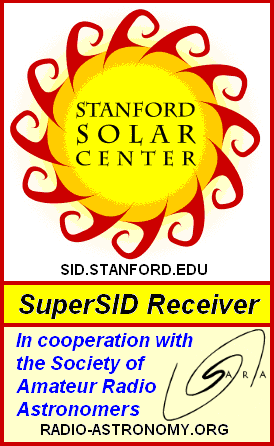SARA Beginner Booklet: An introduction to radio astronomy
The Society of Amateur Radio Astronomers provides funds in support of student and teacher grants for projects. The funds will be divided up into several smaller grants of no more than $200, each, without approval of the grant committee, to ensure that the money reaches the largest number of students and teachers.
Inexpensive Microwave Antenna Demonstrations
There are a number of well documented projects to get anyone with an interest started in radio astronomy. Here are just a few projects an amateur starting out might want to try.
Stanford Solar Center and the Society of Amateur Radio Astronomers have teamed up to produce and distribute the SuperSID (Sudden Ionospheric Disturbance) monitor. The monitor utilizes a simple pre-amp to magnify the VLF radio signals which are then fed into a high definition sound card. This design allows the user to monitor and record multiple frequencies simultaneously. The unit uses a compact 1 meter loop antenna that can be used indoors or outside. This is an ideal project for the radio astronomer that has limited space. To request a unit, send an e-mail to supersid_at_radio-astronomy_dot_org.
The Radio Jove Project monitors the storms of Jupiter, solar activity and the galatic background. The radio telescope can be purchased as a kit or you can order it assembled. They have a terrific user group you can join.

- The INSPIRE Project The INSPIRE program uses build-it-yourself radio telescope kits to measure and record VLF emissions such as tweeks, whistlers, sferics, and chorus along with man-made emissions. This is a very portable unit that can be easily transported to remote sites for observations.
- SkyScan Awareness Project in Canada has a great website explaining how to build a meteor detection unit and make observations. You can utilize a Chrysler digital car radio from the late 70's to 90's or a variety of other FM radios. The Chrysler radio is very well shielded, available for cheap and if you have a little skill it can be made to detect meteors.
- The Itty Bitty Telescope (IBT) can be made from a small TV satellite dish. It is highly portable radio telescope used to demonstrate basics about radio astronomy. It can be connected to a computer running Sky Pipe software or a strip chart recorder. SARA has a more sophisticated model used in the Navigator program. You can build your own IBT and perform your own experiment to measure the antenna gain and aiming accuracy
- SDR Radio project - a step-by-step article of one member's experience exploring 5 projects with SDR (Software Defined Radio) radio astronomy.
- Math Support Pack courtesy of University of Central Lancashire. For more information on UCLan: http://www.studyastronomy.com
- Glossary of Radio Astronomy Abbreviations and Acronyms
- Education Links
QEX Articles
- Radio Signals from Jupiter
- Total Power Radio Telescope
- Amateur Radio Astronomy Projects
- A Whistler Radio
(Thanks QEX Magazine for permission to re-publish the articles on our web site)

